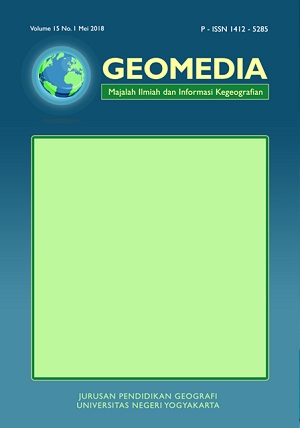APLIKASI SIG UNTUK PENENTUAN DISTRIBUSI OPTIMAL RUANG TERBUKA HIJAU KOTA YOGYAKARTA
DOI:
https://doi.org/10.21831/gm.v5i1.14201Abstract
The aims of this research are: 1) to build city environment spatial database using GIS based on Quickbird Satellite Imagery interpretation, secondary data, and field data, 2) to make city green space optimal model based on city environmental spatial database, and 3) to apply the model in form of Yogyakarta City Green Space Optimal Map.
Research method mainly consists of four steps, they are: 1) collecting primary data and secondary data, 2) building the database, 3) arrange city green space optimal model, and 4) apply the model. Primary data are Quickbird satellite imagery and field measurement, while the secondary data obtained from the related institutions. Parameters that were used to build city environment database are comfortable level, number and distance from traffic light, number and distance from main road intersection, the distance from main road, air and noise pollution of each land use category, qualitative of inhabitant oxygen necessity of each land use category, actual green space, and potential land for green space. The database consits of spatial data in vector format and attribute data in relational structure. Spatial model was built from three overlay methods in sequencial way : they are rating method, weighted rating method, and join spatial method.
The results of the research are: 1) from the imagery can be produced Land Use, Road Network, Green Space, Potential Land for Green Space Maps with interpretation accuracy are 91.1%, 100%, 95.8%, and 94.8% respectively, 2) GIS procedure is able to build city environment spatial database and to perform a model of city green space optimal distribution, 3) The need of green space is 1022.9 ha, actual green space available is 94.87 ha, and potential land for green space in Yogyakarta city is 111.92 ha, 4) Distribution of the need of green space are along the main roads and its intersections. The areas cover along the roads of : 1) Adisucipto-Urip Sumoharjo– Sudirman–Diponegoro – Kyai Mojo–Godean streets (to city boundary), 2) Kusumanegara-Sultan Agung-Ahmad Dahlan–Wirobrajan–Martadinata streets (to city boundary), 3) Supeno-Sugiono–Sutoyo–M.T.Haryono–Sugeng Jeroni streets, 4) Magelang,-Herman Yohannes-Sutomo–Suryopranoto-Bausasran–Juminahan–Suryat majan–Gadjah Mada-Mataram–Suryotomo streets, 5) Cokroaminoto–Kapten Tandean–Bugisan (to city boundary), Suprapto–Wahid Hasyim–Bantul streets, and 6) Katamso–Parangtritis streets (to city boundary).
Key words : Quickbird Imagery, Geographical Information System, Spatial Modelling, City Green Space Optimal Distribution
Downloads
Published
How to Cite
Issue
Section
Citation Check
License
Authors who publish in this journal agree to the following terms:
- Authors retain copyright and grant the journal the right of first publication with the work simultaneously licensed under a Creative Commons Attribution License that allows others to share the work with an acknowledgment of the work's authorship and initial publication in this journal.
- Authors are able to enter into separate, additional contractual arrangements for the non-exclusive distribution of the journal's published version of the work (e.g., post it to an institutional repository or publish it in a book), with an acknowledgment of its initial publication in this journal.
- Authors are permitted and encouraged to post their work online (e.g., in institutional repositories or on their website) prior to and during the submission process, as it can lead to productive exchanges, as well as earlier and greater citation of published work (See The Effect of Open Access).

Geo Media: Majalah Ilmiah dan Informasi Kegeografian is licensed under a Creative Commons Attribution-ShareAlike 4.0 International License.
Based on a work at https://journal.uny.ac.id/index.php/geomedia.











